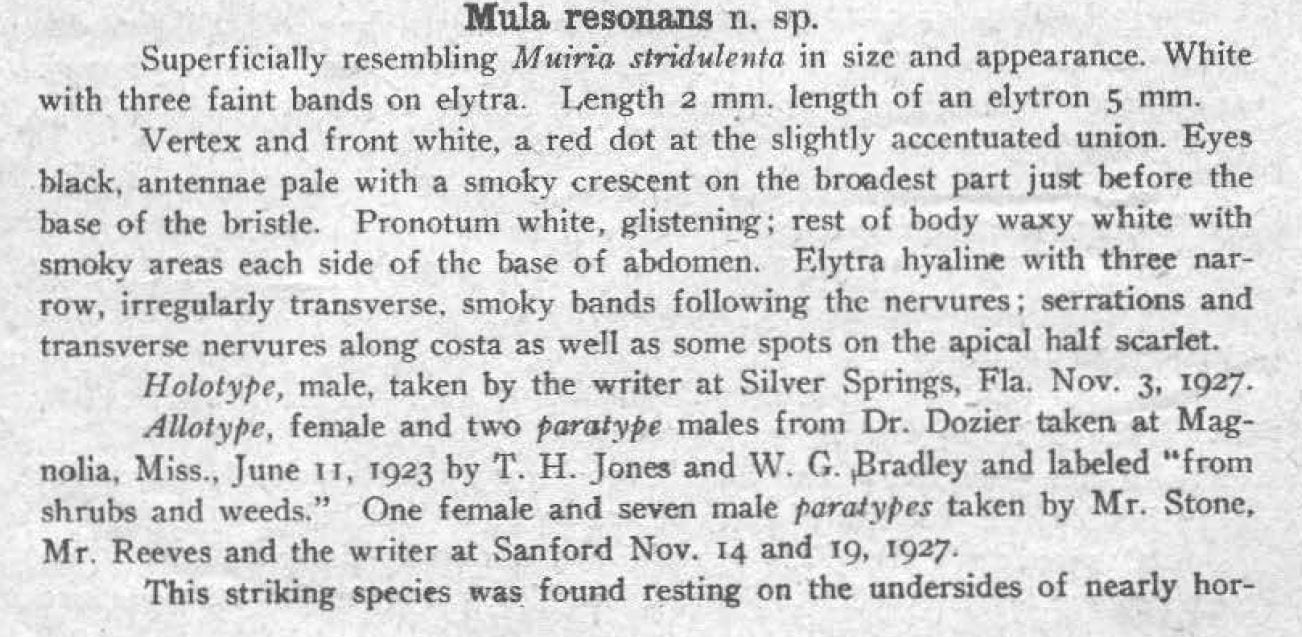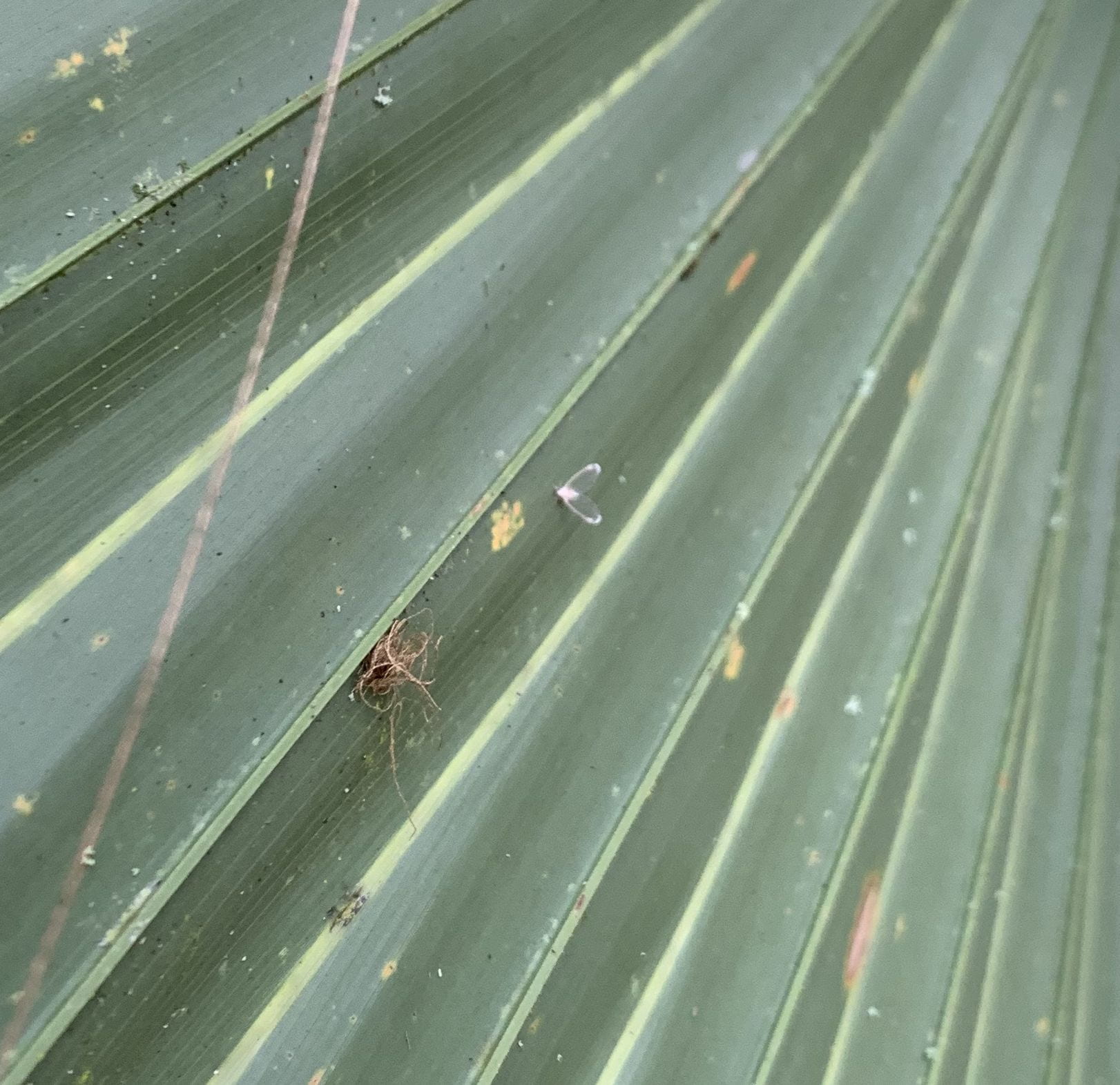[Back to North American Derbidae]
Contents
- 1 Family Derbidae Spinola, 1839
Family Derbidae Spinola, 1839
Subfamily Otiocerinae Muir, 1917
Tribe Sikaianini Muir, 1913
Genus Mula Ball, 1928
Type species (in original combination): Mula resonans Ball, 1928.
Synonyms
None.
Distribution
Southwest USA and Caribbean, plus one species in Taiwan and one in Brazil.
Recognized species
There are four recognized species in the genus:
- Mula chushanensis Yang & Wu, 1993 – Taiwan
- Mula flamma Bitar & Domahovski, 2025 – Brazil (Mato Grosso)
- Mula resonans Ball, 1928 [Metcalf 1945: 62]- USA: FL, LA, MS
- Mula thrinacis Fennah, 1952: 117 – St. Lucia
Economic Importance
Species are infrequently encountered, but Mula resonans is reported to be on palms.
Plant associations
Derbidae are known or assumed to feed on fungal hyphae as immatures. The significance of adult host associations is unclear. Hosts from Fennah (1952) and Wilson et al. (1994); plant names from USDA PLANTS or Tropicos.
Mula resonans – Sabal palmetto (Walter) Lodd. ex Schult. & Schult. f. (cabbage palmetto, Arecaceae)
Mula thrinacis – Thrinax sp. (Arecales, Arecaceae) according to Fennah 1952: 117.
Recognition
Small, very fragile forms; wings greatly exceeding abdomen, frons extremely compressed, antennae lacking appendages, head only slightly projecting in front of eyes (less than diameter of eye), clavus open, first cell of forewing distinctly triangular, widest at midlength, narrowed both anteriorly and posteriorly; dark markings on wing mostly along veins; hindwings narrow, strap-shaped, with two longitudinal veins.
It appears that Mula resonans is on Sabal palmetto, but these were hardly in the deep shade of the densest swamps.
Mula resonans (photographs by Kimberley Shropshire, University of Delaware; the top right photo is a better representation of how they carry their wings at rest, even though it is covered with junk from a malaise trap; I have seen very few of these).
Fennah 1952: 117 notes ,”This species [thrinacis] differs from M. resonans Ball in tegminal coloration. Mula differs from Muiria and Sikaiana in tegminal venation, and from the latter in possessing very much smaller wings (which in S. hyalinata, the type species, are about half as long as the tegmina) and three extra spines at the apex of the post-tibiae.”

Mula flamma Bitar & Domahovski, 2025 (from original description)
Online resources
Taxonpages.
iNaturalist.
EOL.
Bugguide. (As of this writing, there are no photos of Mula on Bugguide; link to subfamily.)
Discover Life.
FLOW.
American Insects. (Genus not present, link to family)
BOLD. (Genus not present, link to subfamily)
Collecting
Most of the observed specimens were found in malaise traps; however, Mula resonans has been found inspecting Sabal palmetto.
Molecular resources
As of this writing (10 Oct. 2018), there appears to be no molecular data for this genus on Genbank OR Barcode of Life.
Selected references
Ball, E.D. 1928. Some new genera and species of N. A. Derbidae with notes on others (Fulgoridae). Canadian Entomologist 60: 196–201.
Bartlett, C.R., L.B. O’Brien & S.W. Wilson. 2014. A review of the planthoppers (Hemiptera: Fulgoroidea) of the United States. Memoirs of the American Entomological Society 50: 1–287.
Bitar, M.V.S. & A.C. Domahovski. 2025. Uncovering Brazilian Otiocerinae (Hemiptera: Fulgoromorpha: Derbidae): description of three new species and first records for the tribes Sikaianini Muir, 1913 and Patarini Emeljanov, 1995. Zootaxa 5637 (2): 271–291. https://doi.org/10.11646/zootaxa.5637.2.3
Emeljanov, A.F. 1996. On the system and phylogeny of the family Derbidae (Homoptera, Cicadina). Entomological Review 75: 70-100). (Translation of Entomologicheskoe Obozrenie (1995) 73: 783–811, Russian summary 946–947).
Fennah, R.G. 1952. On the generic classification of Derbidae (Fulgoroidea), with descriptions of new Neotropical species. Transactions of the Royal Entomological Society of London 103(4): 109–170.
Metcalf, Z.P. 1945. General Catalogue of the Hemiptera. Fascicle IV, Fulgoroidea, Part 4, Derbidae. Smith College, Northampton, Massachusetts. [p. 62]
Muir, F.A.G. 1913. On some new species of leafhoppers. Part II. Derbidae. Bulletin. Hawaiian Sugar Planters’ Association Experiment Station. Division of Entomology 12: 28–92.
Muir, F.A.G. 1917. The Derbidae of the Philippine Islands. Philippine Journal of Science 12: 49–105.
Spinola, M. 1839. Essai sur les Fulgorelles, sous-tribu de la tribu des Cicadaires, ordre des Rhyngotes. Annales de la Société Entomologique de France 8: 133–337.
Yang, Chung-Tu & Rong-Hwa Wu. 1993. Derbidae of Taiwan (Homoptera: Fulgoroidea). National Chung Hsing University, Department of Entomology, Taichung (China, Taiwan). 230 pp.
Wilson, S.W. & J.E. McPherson. 1980b. The distribution of the Fulgoroidea of the eastern United States (Homoptera). Transactions of the Illinois Academy of Science 73(4): 7–20.
Wilson, S.W., C. Mitter, R.F. Denno & M.R. Wilson. 1994. Evolutionary patterns of host plant use by delphacid planthoppers and their relatives. In: R.F. Denno & T.J. Perfect, (eds.). Planthoppers: Their Ecology and Management. Chapman and Hall, New York. Pp. 7–45 & Appendix.












